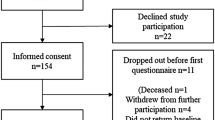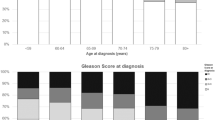Abstract
Purpose
To assess quality of life (QOL) data from a double-blind Phase III study evaluating bicalutamide (Casodex™) 80 mg as part of maximum androgen blockade (MAB) in patients with previously untreated advanced prostate cancer.
Methods
Patients with untreated stage C/D prostate cancer were randomized to MAB with bicalutamide plus a luteinizing hormone-releasing hormone agonist (LHRHa) or LHRHa monotherapy. QOL was evaluated at baseline and at weeks 1, 5, and 24 using the Japanese version of the Functional Assessment of Cancer Therapy-Prostate (FACT-P) questionnaire.
Results
A total of 203 patients were assessed for QOL. The MAB group had more rapid and greater improvements in “emotional well-being” and “prostate cancer-specific issues” domain scores than the monotherapy group. Further analysis of “prostate cancer-specific issues” revealed that, compared with monotherapy, MAB provided a greater improvement in “micturition disorder”-related QOL. Complete improvement rates for items related to “pain and micturition disorder” were also higher with MAB. Item scores of “pain and micturition disorder” did not correlate strongly with prostate-specific antigen levels or tumor size. Fewer patients who had deterioration in their “pain and micturition disorder” item scores at week 1 in the MAB group than the monotherapy group.
Conclusions
Maximum androgen blockade with bicalutamide plus LHRHa did not reduce the overall QOL of patients with previously untreated advanced prostate cancer. MAB was superior to monotherapy in achieving early improvement of QOL related to micturition disorder and pain.


Similar content being viewed by others
References
Akaza H (1999) Prostate cancer therapy and anti-androgens: recent trends. Jpn J Urol Surg 12:623–624
Akaza H, Yamaguchi A, Matsuda T et al (2004) Superior anti-tumor efficacy of bicalutamide 80 mg in combination with a luteinizing hormone-releasing hormone (LHRH) agonist versus LHRH agonist monotherapy as first-line treatment for advanced prostate cancer: interim results of a randomized study in Japanese patients. Jpn J Clin Oncol 34:20–28
Akaza H, Yoshida H, Takimoto Y et al (2005) Bicalutamide 80 mg in combination with an LHRHa versus LHRHa monotherapy in previously untreated advanced prostate cancer: a double-blind, placebo controlled trial. J Clin Oncol 23:16S
Clark JA, Bokhour BG, Inui TS, Silliman RA, Talcott JA (2003) Measuring patients’ perceptions of the outcomes of treatment for early prostate cancer. Med Care 41:923–936
Da Silva FC, Reis E, Costa T, Denis L (1993) Quality of life in patients with prostatic cancer. A feasibility study. The Members of Quality of Life Committee of the EORTC Genitourinary Group. Cancer 71:1138–1142
Efficace F, Bottomley A, van Andel G (2003) Health related quality of life in prostate carcinoma patients: a systematic review of randomized controlled trials. Cancer 97:377–388
Eisenberger MA, Blumenstein BA, Crawford ED et al (1998) Bilateral orchiectomy with or without flutamide for metastatic prostate cancer. N Engl J Med 339:1036–1042
Esper P, Mo F, Chodak G, Sinner M, Cella D, Pienta KJ (1997) Measuring quality of life in men with prostate cancer using the functional assessment of cancer therapy-prostate instrument. Urology 50:920–928
Hinotsu A, Niimi M, Akaza H et al (1999) Development of Japanese version of QOL questionnaire for bladder and prostate cancer patients using FACT-Bl and P: pilot study. Gan To Kagaku Ryoho 26:657–666
Kaisary AV (1996) Compliance with hormonal treatment for prostate cancer. Br J Hosp Med 55:359–366
Klotz L, Schellhammer P, Carroll K (2004) A re-assessment of the role of combined androgen blockade for advanced prostate cancer. BJU Int 93:1177–1182
Lee WR, Hall MC, McQuellon RP, Case LD, McCullough DL (2001) A prospective quality-of-life study in men with clinically localized prostate carcinoma treated with radical prostatectomy, external beam radiotherapy, or interstitial brachytherapy. Int J Radiat Oncol Biol Phys 51:614–623
Litwin MS, Lubeck DP, Spitalny GM, Henning JM, Carroll PR (2002) Mental health in men treated for early stage prostate carcinoma: a posttreatment, longitudinal quality of life analysis from the Cancer of the Prostate Strategic Urologic Research Endeavor. Cancer 95:54–60
McLeod DG, Crawford ED, Blumenstein BA, Eisenberger MA, Dorr FA (1992) Controversies in the treatment of metastatic prostate cancer. Cancer 70:324–328
Nagakubo I, Horiba M, Arima S, Morikawa T, Kato S (2002) Assessment of QOL over time in 146 patients treated with radical prostatectomy. Jpn J Urol Surg 15:1031–1039
Prostate Cancer Trialists’ Collaborative Group (2000) Maximum androgen blockade in advanced prostate cancer: an overview of the randomised trials. Lancet 355:1491–1498
Schellhammer PF, Sharifi R, Block NL, Soloway MS, Venner PM, Patterson AL, Sarosdy MF, Vogelzang NJ, Schellenger JJ, Kolvenbag GJ (1997) Clinical benefits of bicalutamide compared with flutamide in combined androgen blockade for patients with advanced prostatic carcinoma: final report of a double-blind, randomized, multicenter trial. Casodex Combination Study Group. Urology 50:330–336
Sugiono M, Winkler MH, Okeke AA, Benney M, Gillatt DA (2005) Bicalutamide vs cyproterone acetate in preventing flare with LHRH analogue therapy for prostate cancer-a pilot study. Prostate Cancer Prostatic Dis 8:91–94
Usami M, Akaza H, Arai Y, Hirano Y, Kagawa S, Kanetake H, Naito S, Sumiyoshi Y, Takimoto Y, Terai A, Yoshida H, Ohashi Y (2007) Bicalutamide 80 mg combined with a luteinizing hormone-releasing hormone agonist (LHRH-A) versus LHRH-A monotherapy in advanced prostate cancer: findings from a phase III randomized, double-blind, multicenter trial in Japanese patients. Prostate Cancer Prostatic Dis 10:194–201
Wagner G, Béjin A, Fugl-Meyer AR et al (2000) Symptom score and quality of life. In: Jardin A, Wagner G, Khoury S, Giuliano F, Padma-Nathan H, Rosen R (eds) Erectile dysfunction. Health Publication Ltd, Plymouth, pp 102–113
Yoshida M, Ueda S, Machida J et al (1997) Antitumour effect of leuprorelin acetate on prostate cancer and its effect on QOL. Jpn J Urol Surg 10:799–807
Acknowledgments
We thank all the patients for their participation in this study. We also thank the doctors and support staff in each institute, and Chris Rapier PhD for providing editorial assistance. Financial sponsorship for this trial was provided by AstraZeneca.
Author information
Authors and Affiliations
Corresponding author
Appendix
Appendix
Question items in the FACT-P questionnaire (version 4A).
Not at all | A little bit | Some-what | Quite a bit | Very much | |
|---|---|---|---|---|---|
Physical well-being | |||||
(1) I have a lack of energy | 0 | 1 | 2 | 3 | 4 |
(2) I have nausea | 0 | 1 | 2 | 3 | 4 |
(3) Because of my physical condition, I have trouble meeting the needs of my family | 0 | 1 | 2 | 3 | 4 |
(4) I have pain | 0 | 1 | 2 | 3 | 4 |
(5) I am bothered by side effects of treatment | 0 | 1 | 2 | 3 | 4 |
(6) I feel ill | 0 | 1 | 2 | 3 | 4 |
(7) I am forced to spend time in bed | 0 | 1 | 2 | 3 | 4 |
Social/family well-being | |||||
(1) I feel close to my friends | 0 | 1 | 2 | 3 | 4 |
(2) I feel close to my familya | 0 | 1 | 2 | 3 | 4 |
(3) I get emotional support from my family | 0 | 1 | 2 | 3 | 4 |
(4) I get support from my friends | 0 | 1 | 2 | 3 | 4 |
(5) My family has accepted my illness | 0 | 1 | 2 | 3 | 4 |
(6) I am satisfied with family communication about my illness | 0 | 1 | 2 | 3 | 4 |
(7) Although I am ill, my family has a satisfactory lifea | 0 | 1 | 2 | 3 | 4 |
(8) I feel close to my partner (or the person who is my main support) | 0 | 1 | 2 | 3 | 4 |
Regardless of your current level of sexual activity, please answer the following question. If you prefer not to answer it, please check this box □ and go to the next section | |||||
(9) I am satisfied with my sex life | 0 | 1 | 2 | 3 | 4 |
Emotional well-being | |||||
(1) I feel sad | 0 | 1 | 2 | 3 | 4 |
(2) I am satisfied with how I am coping with my illness | 0 | 1 | 2 | 3 | 4 |
(3) I am losing hope in the fight against my illness | 0 | 1 | 2 | 3 | 4 |
(4) I feel nervous | 0 | 1 | 2 | 3 | 4 |
(5) I worry about dying | 0 | 1 | 2 | 3 | 4 |
(6) I worry that my condition will get worse | 0 | 1 | 2 | 3 | 4 |
Functional well-being | |||||
(1) I am able to work (include work at home) | 0 | 1 | 2 | 3 | 4 |
(2) My work (include work at home) is fulfilling | 0 | 1 | 2 | 3 | 4 |
(3) I am able to enjoy life | 0 | 1 | 2 | 3 | 4 |
(4) I have accepted my illness | 0 | 1 | 2 | 3 | 4 |
(5) I am sleeping well | 0 | 1 | 2 | 3 | 4 |
(6) I am enjoying the things I usually do for fun | 0 | 1 | 2 | 3 | 4 |
(7) I am content with the quality of my life right now | 0 | 1 | 2 | 3 | 4 |
Additional concernsb | |||||
(1) I am losing weight | 0 | 1 | 2 | 3 | 4 |
(2) I have a good appetite | 0 | 1 | 2 | 3 | 4 |
(3) I have aches and pains that bother me | 0 | 1 | 2 | 3 | 4 |
(4) I have certain parts of my body where I experience significant pain | 0 | 1 | 2 | 3 | 4 |
(5) My pain keeps me from doing things I want to do | 0 | 1 | 2 | 3 | 4 |
(6) I am satisfied with my present comfort level | 0 | 1 | 2 | 3 | 4 |
(7) I am able to feel like a man | 0 | 1 | 2 | 3 | 4 |
(8) I have trouble moving my bowels | 0 | 1 | 2 | 3 | 4 |
(9) I have difficulty urinating | 0 | 1 | 2 | 3 | 4 |
(10) I urinate more frequently than usual | 0 | 1 | 2 | 3 | 4 |
(11) My problems with urinating limit my activities | 0 | 1 | 2 | 3 | 4 |
(12) I am able to have and maintain an erection | 0 | 1 | 2 | 3 | 4 |
Rights and permissions
About this article
Cite this article
Arai, Y., Akaza, H., Deguchi, T. et al. Evaluation of quality of life in patients with previously untreated advanced prostate cancer receiving maximum androgen blockade therapy or LHRHa monotherapy: a multicenter, randomized, double-blind, comparative study. J Cancer Res Clin Oncol 134, 1385–1396 (2008). https://doi.org/10.1007/s00432-008-0409-z
Received:
Accepted:
Published:
Issue Date:
DOI: https://doi.org/10.1007/s00432-008-0409-z




